Dear Barbara,
Etna’s shadow constantly covers Catania. The volcano seems to have more than one role in the city. No matter where you walk in Catania, you can still catch glimpses of that smoky mountain. Of course, that’s not a surprise: Etna is the highest and most active volcano in Europe. There are constant eruptions that paint the city’s sky.
But Etna is actually a set of things: an urban planner, a historical leader, a prolific architect, and a pessimist poet. You see, Etna has reshaped the city several times in the past. Back in 1669, the lava even reached the port of Catania -but caused fewer deaths than the earthquake that followed 24 years later, in 1693, that demolished the city.
Etna is a spectacle, and this volcano has even hosted Hephaestus. The word Etna derives from the Greek word αἴθω (aithō), which stands for “I burn.” The whole city of Catania seems to be a tribute to the volcano. I walk down the streets, and I can feel some invisible threat from the enormous mountain.
All along the via Etnea
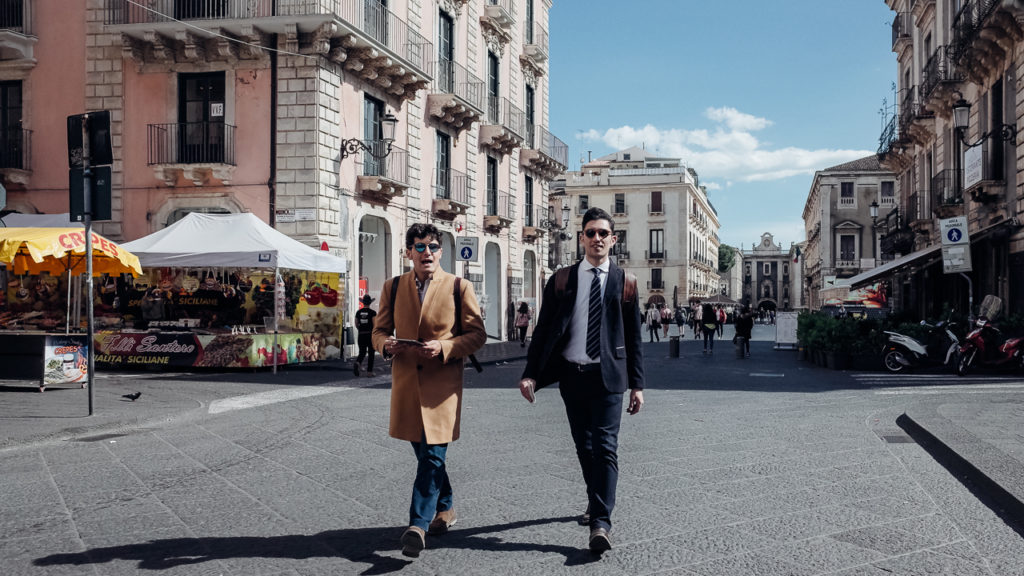
The via Etnea never sleeps. Of all the roads in Catania, this one has the most uninterrupted mountain views. From the moment I step my foot in Catania, I keep in mind the book Under the Volcano by Malcolm Lowry. Walk towards the sea, and you feel like carrying some weight because Etna is on your back; walk towards the volcano, and you can see it at all times.
This is one of the nicest streets of Catania, the place where you come to see and be seen. The baroque architecture of Catania finds its best expression in Via Etnea. The buildings are well preserved here, and the constant greyness is probably an impulsive tribute to everything the lava left behind.
I stroll every day around the Via Etnea, and in the late afternoon, I find a place for an Aperitivo. It’s usually when the sun is not hot anymore, and the body requests both energy and relaxation. I order either a Negroni or an Aperol, and the waiter brings a big platter with it: all the local specialties are on that plate. The sun reclines, and the locals walk up and down the via Etnea.
The Italian streets are always a theater for me. There are usually too many things happening simultaneously that it’s impossible to follow them all. One scene gives its place to another -no wonder Fellini was Italian and loved Sicily.
For example, one day, two older men talk, but there is suddenly noise: they start to swear. Some workers arrive out of nowhere, and they demolish a kiosk. This is done with noise and chatter. A biker stops in front of them to talk on the phone. He has to scream to be heard; a lady with a dog gets annoyed. She says something to the biker. But while she talks to him, she doesn’t keep an eye on a coming car that stops twenty centimeters from the dog. The car driver stops and screams too. But he stops in the middle of the street, and the bus driver behind him complains. Meanwhile, a man disembarks from the bus. He joins the chat of the two older men.
There is a circularity in the scenes in Sicily, and I sip them slowly together with my via Etnea afternoon Aperitivos.
Bellini, the Swan of Catania
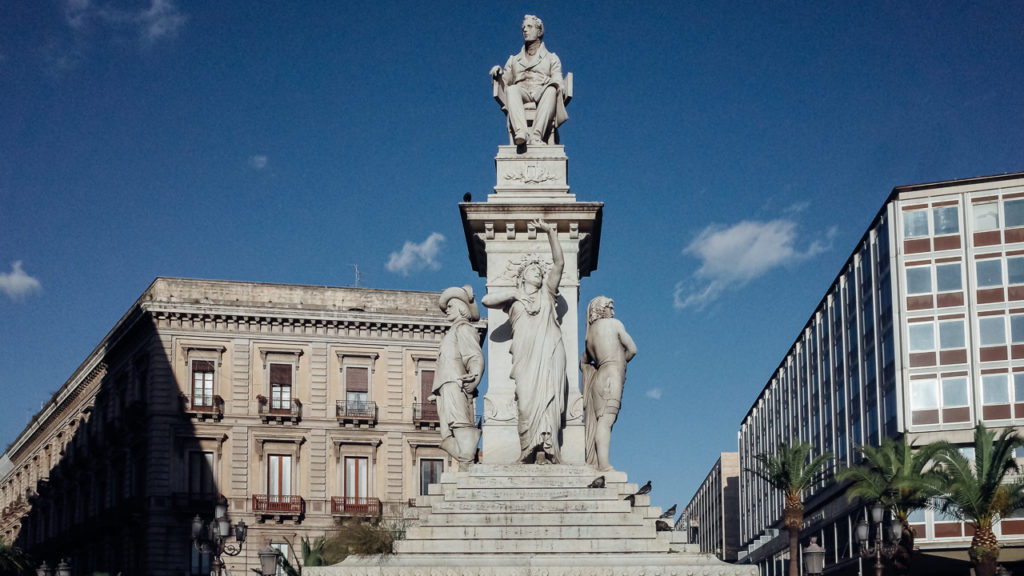
No matter where I go in Catania, there is always a name: Vincenzo Bellini. He was a prolific music composer that influenced the next generations. Many notable composers praised his oeuvre -among them Wagner, Verdi, and Chopin. Although his life was short (he died 34 years old in 1835), Bellini left his mark on history and Catania.
At Piazza Stesicoro in Catania, a beautiful statue dedicated to Bellini was created by Giulio Monteverde in 1882. The Piazza Stesicoro is a vibrant square, and Bellini’s statue seems compatible with the “music” of the square. The monument itself pays a wonderful tribute to the composer. It is fifteen meters high, and on its base, seven steps represent the musical notes. From the seventh musical note starts a column, on top of which the statue of Bellini stands. All around the column, four figures represent the most famous works of Bellini: Norma, La Sonnambula, I Puritani, and Il Pirata.
I keep running on Bellini’s name during my stay in Catania. The airport in Catania is called Bellini, there is a park with his name, and my wonderful accommodation in Catania is called Bellini, too.
The impressive Piazza Duomo of Catania
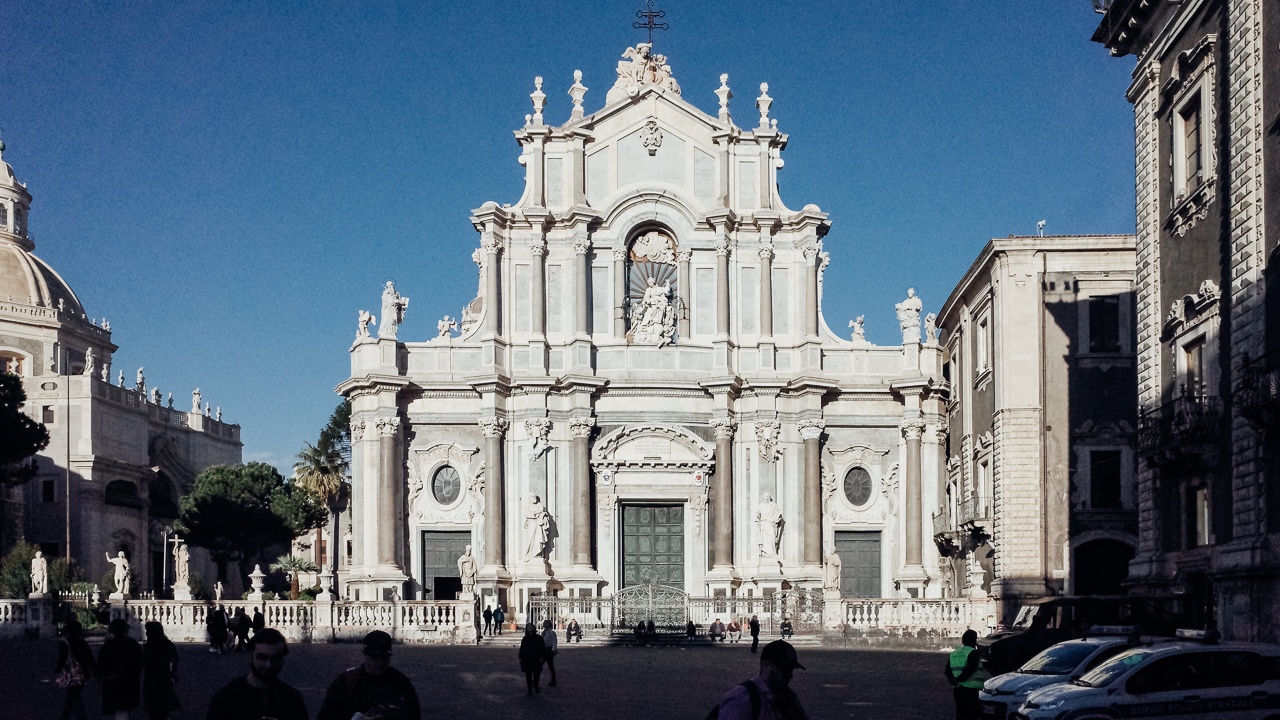
All the three main streets of Catania -Via Etnea, Via Vittorio Emanuele and Via Garibaldi- cross the Piazza Duomo. The square is lively, and it’s a beautiful example of Italian architecture.
The Cathedral of Saint Agatha is the most impressive building here, also called Duomo. Saint Agatha protects the city and is celebrated every 5th of February. The Cathedral of Catania was destroyed in the earthquake of 1693 and was restored almost several decades later, in 1761, by Vaccarini. White and grey marble was used in the reconstruction, and to me, those two colors seem to be the official colors of Catania. It might not be that flamboyant like the Duomo of Florence, but it’s beautiful beyond words.
The Saint’s story goes so deep in Catania’s collective mindset that there is even a Sicilian sweet dedicated to her. In most paintings, Saint Agatha has her breasts cut, and she carries them on a platter. The so-called Minne di Sant’Agata (or Saint Agatha’s breast) is a traditional sweet in the shape of a breast. It represents, of course, the cut breasts of Saint Agatha: small white pastries, round in shape, with a cherry on top.
One Mysterious Elephant
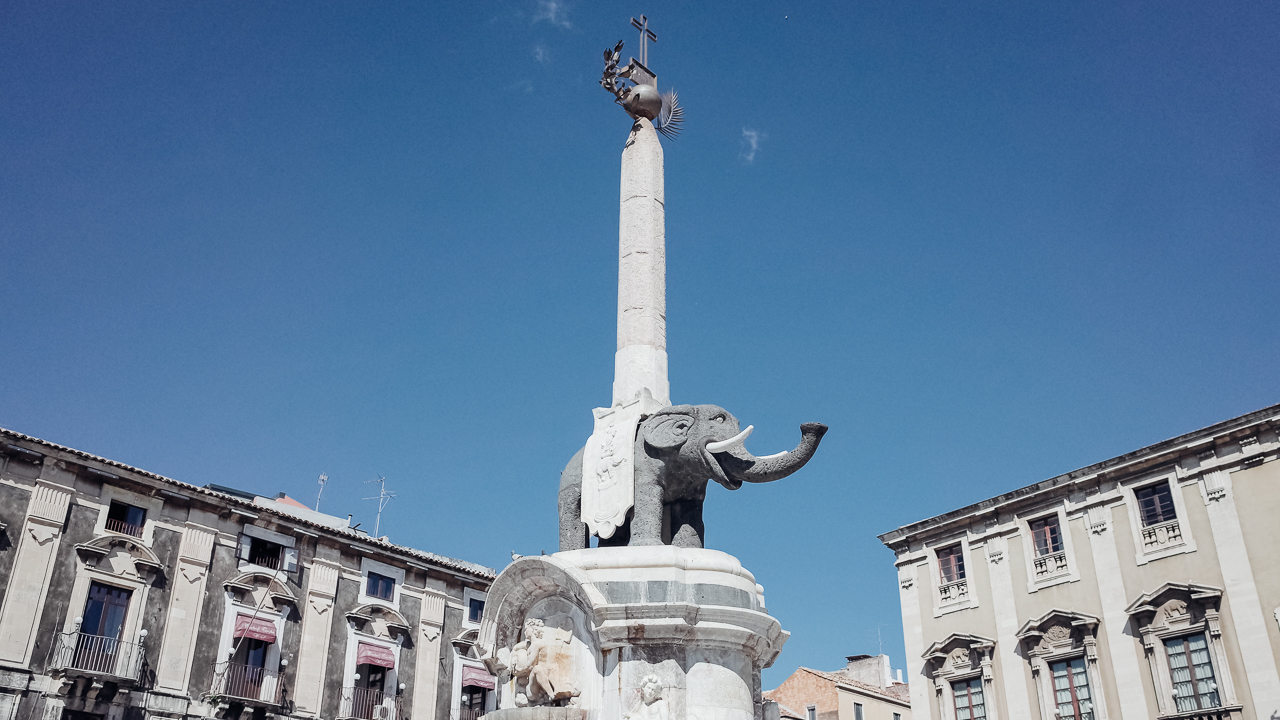
Although Saint Agatha’s Cathedral is definitely magnetizing the eyes, there is an open dialectic with one statue in the Duomo square. It’s the Elephant’s Fountain, also designed by Vaccarini. The Elephant became somehow Catania’s trademark and has a long story behind it.
There are loads of assumptions regarding the Elephant of Catania, standing -but not looking- at Saint Agatha. Some people say that it’s there to remind the victory against the Carthaginians, while others assume it as a symbol of an obscure Eastern religion; of course, some even claim that it can foresee the eruptions of Mount Etna. The speculation is apparently a never-ending one for that elephant known as u Liotru.
No matter what, the Elephant has its own beautiful spot in the Duomo of Catania, sitting on top of a fountain. As if the whole thing is not odd enough, a good part of the pachyderm is dressed with a cloth that features the coat of arms of Saint Agatha. In addition, the Elephant carries an obelisk on its back. It is the symbol of the city, and the Elephant’s Fountain in Duomo is a favorite hangout spot both for locals and tourists.
If you need a taxi in Catania
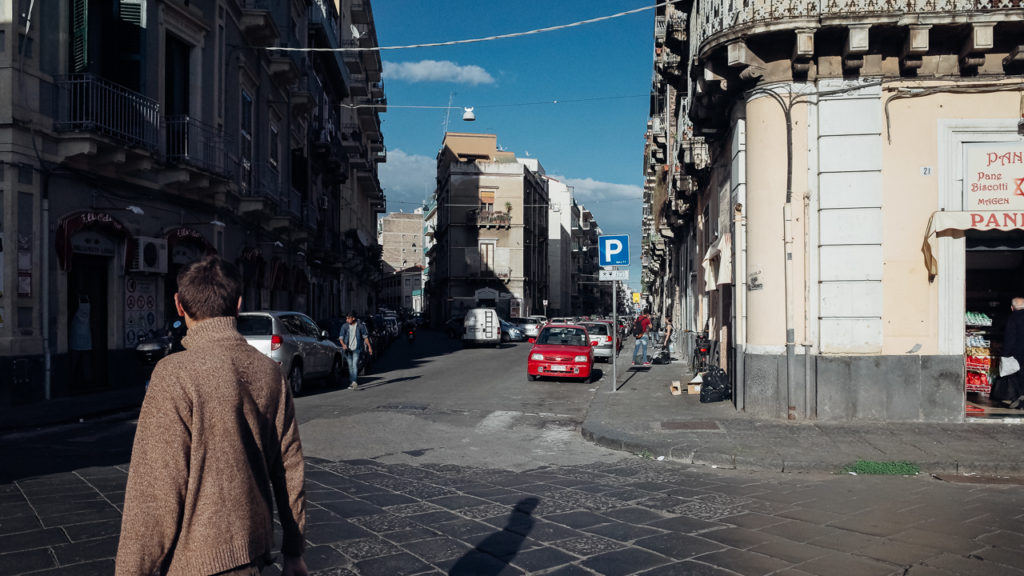
The day I planned to go to Syracuse, I got confused with the departure time of the train. It doesn’t leave a quarter past eleven but a quarter to eleven.
When I realize that, I start being anxious. I dress quickly, and I go out on the street to find a taxi. But for the first two minutes, I couldn’t find any. There is not enough time to walk, and the metro is not an option either. A man is standing in the corner; he has grey hair and deep black eyes. He wears glasses, and he should be in his early sixties. I approach him and ask: “Do you know where I can get a taxi?”
He replies, “Taxi?” -and then he hits the fist in his heart.
“Eh,” it’s my surprised reaction.
“Zehn euro,” he carries on in broken German. He thinks that I come from Germany, probably because there are many German tourists here.
Well, this is the first time that I need a taxi, that I get a taxi, but at the same time, the car is not a taxi. Desperate as I am, I just say, “alright, let’s go.” He nods me to follow him, and we walk two blocks. On the way, some other guy stops me and says, “Buona sera, Gianluca.” He thinks that I am Gianluca Alviggi, a man I’ve never heard of; the same thing also happens at night, in a restaurant. I don’t have time to introduce myself, and soon I sit in the stranger’s car.
It’s a short way to the Central Station of Catania, but the adrenaline is high. It’s not my first time in an Italian car, but it’s definitely the most adventurous. The traffic in Catania is heavy: it could be the traffic of some capital, not of a city of 400,000 inhabitants. The locals probably go everywhere by car. In the ten minutes that the ride lasts, we escape an accident four times, while there is enough time for some swearing and flirting with a “Bella ragazza.” Finally, I arrive in one piece at the train station of Catania, and I have enough time just to buy a ticket and head to the platform.
I give ten euros to the stranger, and I thank him. But then, while walking towards the station, I think this has probably been a rip-off. On the other hand, though, driving in Sicily is quite an experience. For such a precious thing, it’s not like paying a fare; it’s like paying for a theater ticket.
The sweet decay of Catania

All my walks in Catania seem to be following a pattern. I always start from via Etnea, which is the city’s backbone; without it, the city might not even exist. Then, sooner or later, I take either a right or left turn. It doesn’t really matter which street I follow. What matters is that I explore a new neighborhood every time.
As I told you, Catania’s main architectural style is Baroque. But the thing is that most of the city has a rundown feel. Most of the facades are in bad condition, and some of the streets too. I like to study the faces of the places I visit, and Catania doesn’t seem to be a thriving city. On the contrary, there is poverty here. But what saves the day is the atmosphere.
One might expect that a relatively poor place will have a bad mood and long faces. But in Catania, probably because its citizens are proud of their place, it is lively. I see people smiling, joking, and enjoying life no matter where I walk. There is a sun in Catania that warms the bones, and there is also some wind coming from the sea that cools down the mind. These two factors sum up my Catania experience -and I think they are made of lava and white marble.
Among street musicians, loads of immigrants, and loud locals, I find real Sicilian life in Catania. Of course, life here is slower than in the north of Italy. But as I was leaving and returning to the city for some excursions, I kept having in mind Pasolini’s journey with his small car. Sicily unfolded to me slowly, as if Etna was sending smoke signals once in a while. After visiting Catania, after spending some more days around the sea, I now know that it’s impossible for me to stay away from the Mediterranean.
Farewell, smoky Catania
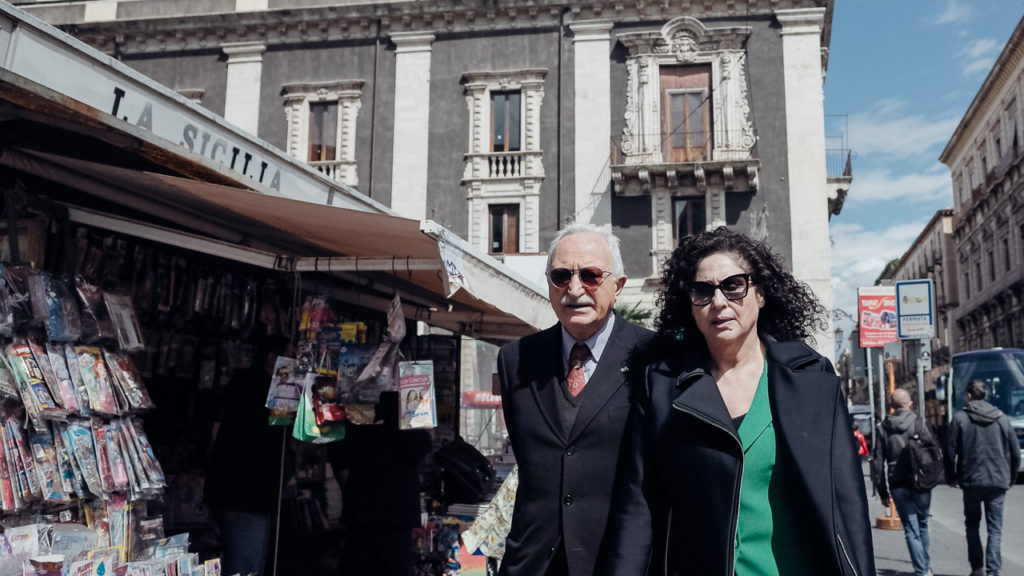
Sometimes, there is smoke coming out of Etna’s crater. That impressive volcano seems to be smoking in peace; one day, though, it will erupt again. Lava, once again, will reshape Catania.
Meanwhile, the locals try to live their life. The main streets are full of people, and the Via Etnea is a pleasure to watch, day and night. The Fish Market of Catania, the famous La Pescheria, resembles an operetta taking place from Monday to Friday; loud voices, salty arguments, and an intense smell of fish. But if there is a place that looks like the apotheosis of Catania, this is the Piazza Stesicoro. It’s the busiest meeting point of Via Etnea, and the traffic is heavy. You don’t find a way to cross the street, you invent it -well, you just move forward and cross it; the drivers seem to respect that kind of courage.
Catanians love cigarettes. The smoking Mount Etna probably dictates that behavior and even applauses it. I see people walking at Piazza Stesicoro holding cigarettes in hand. Sooner or later, a Vespa will take a turn, and from the driver’s lips, there will be a cigarette hanging. Youngsters, older men, and women rushing to work seem to be holding a cigarette. Look down, and you’ll see cigarettes, look up, and see Etna; look at Stesicoro and see a crowd longing for the next puff. People of all ages inhaling nicotine. Their brains are craters full of thoughts, their mouths full of smoke.
All those people that move around the city are tiny Etnas themselves.
I’ll write to you soon,
George
More Catania: The best winery tours starting from Catania, Travel guide to Catania
More about Sicily: Taormina guide, Extra photos, A tour to Etna, I dreamed of Syracuse
*Get my FREE Travel Writing Course*
Buy the camera I use | Book your hotel
Pin it for later
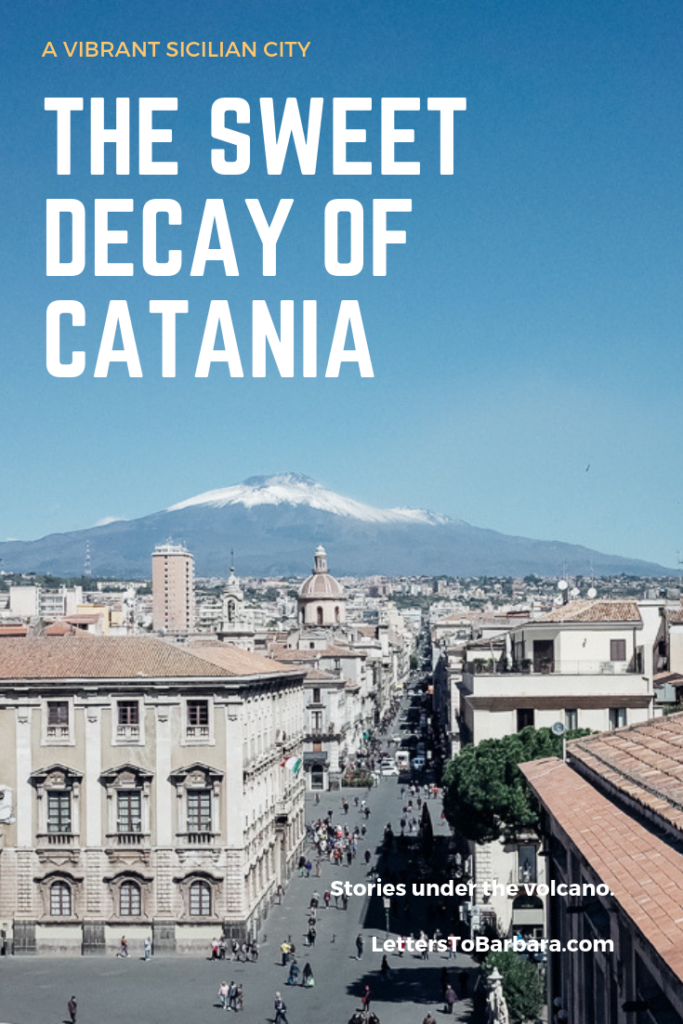
Sharing is caring. If you enjoyed reading The sweet decay of Catania, please share it with your friends.
Last Updated on April 16, 2022 by George Pavlopoulos

Your article gave me a lot of insights of the beautiful architecture and the entire cosmopolitan culture of the place!
I am in love with Catanians after reading this
Thank you, Tanisha. Catania is a beautiful city and it definitely deserves a visit.